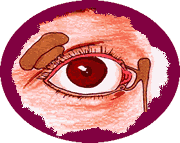
Dimdima
Online Children's Magazine from India

Dimdima
Online Children's Magazine from India

Pause for a few minutes to think of all the things that bring water to your eyes. Cutting onions, a particle of dust falling into your eye, pain, someone scolding you, something that makes you extremely happy!! Have you paused to think what these tears are made up of, and where they come from? I am sure you have tasted tears. What is the taste like ? Salty?
Tears are formed in a tiny gland present in the upper eyelid of your eye, called lachrymal glands; and drain into the nose and mouth. Excess tears spill over the lower eyelid and run down the cheeks.
But the type of tears produced in each of the above conditions is not the same. Each type of tear has its own purpose and therefore a different chemical makeup. The main purpose of tears is to smoothen the surface of the eye. Did you know that the eyes have a continuous supply of tears? These tears act as oxygen suppliers to the eye, carry away waste, destroy harmful bacteria, and in general maintain a healthy eye. . These tears contain salts, proteins and an enzyme called lysozyme, which protect and nourish the eye.
However the tears, which are produced as an expression of emotion, are totally different.
Scientists have discovered that emotional tears contain high levels of manganese and a chemical called prolactin. . In fact it is believed that crying is a way of removing “excess” chemicals, which are not very good for the body. This might help explain why people say they feel better after "a good cry."
EXPLORE MORE...
Get Help or Give Help.
- Do you have a Science Question?
- Post it here and get the answer.
- Some questions posted by others are not yet answered.
- View those questions and answer them.
Dimdima is the Sanskrit word for ‘drumbeat’. In olden days, victory in battle was heralded by the beat of drums or any important news to be conveyed to the people used to be accompanied with drumbeats.
Bharatiya Vidya Bhavan
K. M Munshi Marg,
Chowpatty, Mumbai - 400 007
email : editor@dimdima.com
Bharatiya Vidya Bhavan
505, Sane Guruji Marg,
Tardeo, Mumbai - 400 034
email : promo@dimdima.com
Dimdima.com, the Children's Website of Bharatiya Vidya Bhavan launched in 2000 and came out with a Printed version of Dimdima Magazine in 2004. At present the Printed Version have more than 35,000 subscribers from India and Abroad.